Tihar Festival in Nepal
This festival begins from Kartik Krishna Dwadasi to Kartik Shukla Dwitiya in Nepali and October-November in English which altogether lasts for five days.
This festival begins from Kartik Krishna Dwadasi to Kartik Shukla Dwitiya in Nepali and October-November in English which altogether lasts for five days.

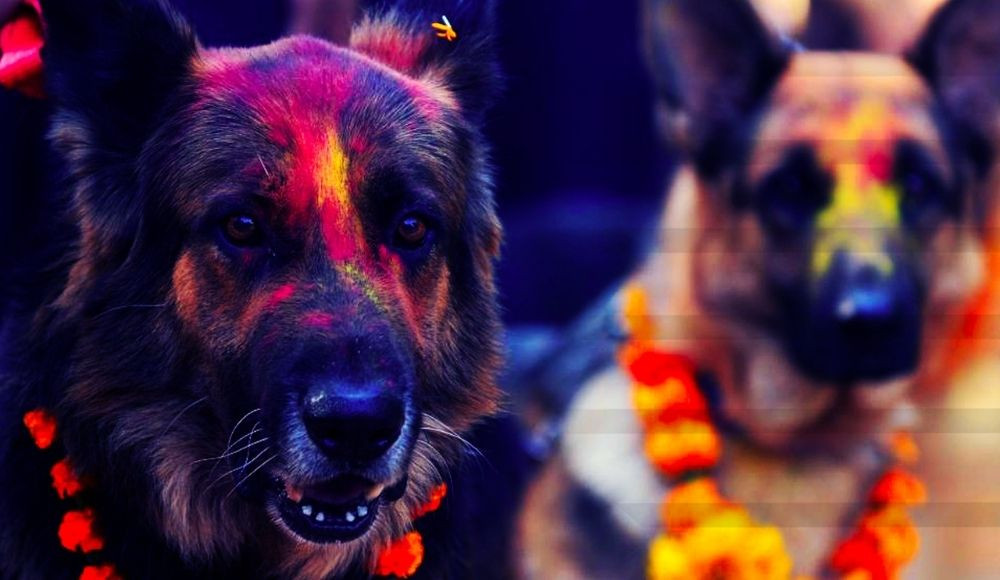
Tihar Festival, also known as Deepawali or Diwali, is a significant and vibrant festival celebrated in Nepal. This auspicious event holds great importance in Nepalese culture and the Hindu religion, as it symbolizes the victory of light over darkness and good over evil. The festival is also called the "Festival of Lights" due to the widespread use of lamps, candles, and firecrackers, which illuminate the nights and create a festive atmosphere.
Tihar Festival is an annual event that typically spans five days, with each day having its own unique rituals, customs, and celebrations. The festival takes place in the lunar month of Kartik (October-November) and coincides with the harvest season, adding to the festive spirit. The significance of Tihar Festival lies in its ability to bring people together, strengthen relationships, and celebrate the bond between humans, animals, and nature.
During the five days of Tihar, various deities and animals are honored with offerings and rituals, highlighting the harmonious coexistence of all living beings. Additionally, the festival is marked by the worship of Goddess Laxmi, the deity of wealth and prosperity, which is believed to bring good fortune and abundance to the people. Tihar is not only a time for spiritual reflection and renewal, but also a chance for families and communities to come together, share happiness, and create lasting memories.
The Tihar Festival, deeply rooted in ancient mythology and Hindu religious beliefs, celebrates the victory of good over evil and the importance of relationships among humans, animals, and nature. Originating from the story of Lord Yama and his sister Yamuna, the festival highlights the bond between siblings, emphasizing the significance of love, protection, and support. Tihar's various customs, rituals, and traditions reflect the diverse beliefs and practices of the Nepalese people, making it an integral part of the country's cultural heritage. The festival serves as a reminder of the core values and spiritual essence of the Hindu religion while promoting unity, shared joy, and the importance of maintaining strong bonds within the community.
One of the popular mythological origins of Tihar Festival is associated with Lord Yama, the Hindu god of death, and his sister Yamuna. According to the legend, Yamuna was deeply worried about the well-being of her brother, Lord Yama, as they were separated for a long time. To console her, Lord Yama sent a crow as a messenger, assuring her of his safety and well-being. In return, Yamuna sent a garland of flowers and a Tika (a colored mark applied to the forehead) for her brother as a symbol of her love and prayers for his long life.
When Lord Yama finally visited his sister, they spent quality time together, and Yamuna performed special rituals to ensure her brother's longevity and safety. Touched by her love and devotion, Lord Yama granted her a boon. Yamuna wished that any brother who receives a Tika and blessings from his sister on this day would be blessed with a long and healthy life. This marked the beginning of the Bhai Tika tradition during the Tihar Festival.
Another significant aspect of Tihar Festival is the celebration of the victory of good over evil. This is symbolized by the lighting of lamps, candles, and firecrackers during the five-day festival. The light is believed to ward off darkness and negative energies, signifying the triumph of knowledge over ignorance and righteousness over wickedness.
In the Hindu epic Ramayana, it is said that Lord Rama returned to his kingdom Ayodhya after defeating the demon king Ravana and rescuing his wife Sita. The people of Ayodhya welcomed Rama, Sita, and his brother Lakshmana by lighting oil lamps, which marked the beginning of the tradition of lighting lamps during the festival.
These ancient mythological origins highlight the core values of Tihar Festival - love, devotion, and the victory of good over evil - which continue to shape the festival's celebrations and significance today.
Tihar Festival emphasizes the interconnectedness of humans, animals, and nature, and the significance of maintaining harmony among all living beings. Each day of the festival is dedicated to honoring a particular animal or deity, recognizing their unique role in our lives and the ecosystem. For instance, crows, dogs, and cows are honored and worshipped on different days during Tihar, highlighting the importance of these creatures in Hindu mythology and Nepalese culture. These rituals help foster a sense of gratitude and respect towards the natural world and its inhabitants.
Tihar Festival plays a crucial role in strengthening relationships among family members, friends, and communities. The festival provides an opportunity for people to come together and spend quality time with their loved ones, creating lifelong memories. The tradition of exchanging gifts, blessings, and good wishes during Tihar fosters a sense of unity, love, and mutual respect. Bhai Tika, the final day of Tihar, is specifically dedicated to celebrating the bond between siblings, where sisters apply a Tika on their brothers' foreheads and pray for their long life and prosperity, while brothers pledge to protect and support their sisters in return.
The spiritual aspect of Tihar Festival is deeply ingrained in its rituals and customs. The worship of different deities, such as Goddess Laxmi, the goddess of wealth and prosperity, highlights the spiritual dimensions of the festival. Lighting lamps, candles, and firecrackers symbolize the dispelling of darkness and ignorance, and the triumph of light and knowledge, reflecting the spiritual journey towards enlightenment and self-realization.
Moreover, the practice of Mha Puja, or self-worship, on the fourth day of Tihar, encourages individuals to reflect on their inner selves, recognize their inherent divinity, and cultivate a sense of self-awareness and spiritual growth. The festival serves as a reminder of the importance of spirituality in our lives and encourages us to nurture our inner selves while also strengthening our connections with others and the natural world.
The Tihar Festival, spanning five days, is a celebration of various aspects of life, highlighting the interconnectedness of humans, animals, and nature. Each day is dedicated to a different subject: Kaag Tihar, honoring the significance of crows in Hindu mythology; Kukur Tihar, paying tribute to the importance of dogs in Hinduism and Nepalese culture; Laxmi Puja, worshipping the Goddess of Wealth and Prosperity; Gobardhan Puja and Mha Puja, venerating cows and the practice of self-worship; and finally, Bhai Tika, a day to celebrate the bond between siblings. These five days of Tihar emphasize the importance of respecting and cherishing the relationships among all living beings, fostering a sense of unity, love, and gratitude within the community.
Crows hold a special significance in Hindu mythology, often symbolizing messengers of death and the link between the living world and the afterlife. They are believed to carry the souls of the departed and are associated with Lord Yama, the god of death. Crows are also considered to be the embodiment of our ancestors, and it is believed that feeding and honoring them during the Tihar Festival can bring good fortune and happiness to the family.
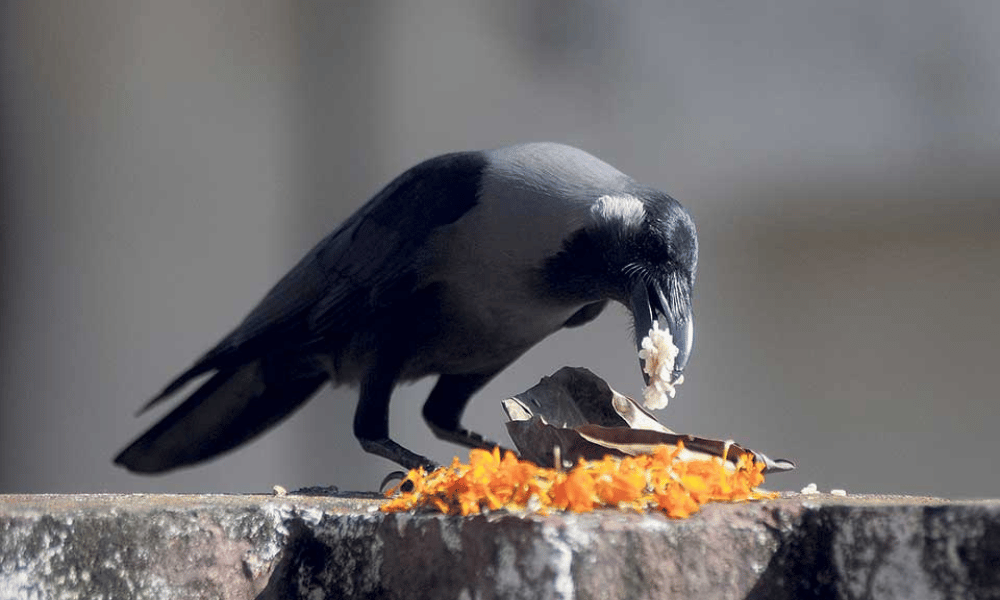
In addition to their spiritual symbolism, crows play an essential ecological role as scavengers, helping maintain a clean environment by consuming waste and dead organisms. Thus, Kaag Tihar serves to remind people of the importance of crows and their dual role in both mythology and the natural world.
Kaag Tihar is celebrated on the first day of the Tihar Festival, during which crows are honored and worshipped. The rituals and customs associated with Kaag Tihar are as follows:
Early in the morning, family members gather to prepare offerings for the crows. These offerings typically include a variety of food items, such as sweets, fruits, nuts, and cooked rice.
The offerings are then placed on rooftops, balconies, or other elevated surfaces accessible to crows. It is believed that feeding crows on this day ensures that they will act as messengers to the afterlife, bringing blessings and good fortune to the family.
In some regions, people also create small shrines or platforms with flowers, incense, and water to honor the crows.
During the day, people avoid harming or disturbing crows, as a sign of respect and reverence towards these creatures.
By honoring crows during Kaag Tihar, people acknowledge their importance in Hindu mythology and the ecosystem, promoting a sense of harmony between humans, animals, and nature.
Dogs have a special place in Hinduism and Nepalese culture, symbolizing loyalty, devotion, and protection. They are regarded as the faithful companions of various deities, including Lord Shiva, who is often depicted with a dog by his side. In Hindu mythology, dogs are also associated with Lord Yama, the god of death, as they are believed to guard the gates of the afterlife. The bond between humans and dogs is celebrated during Kukur Tihar, emphasizing the importance of respecting and caring for these loyal companions.
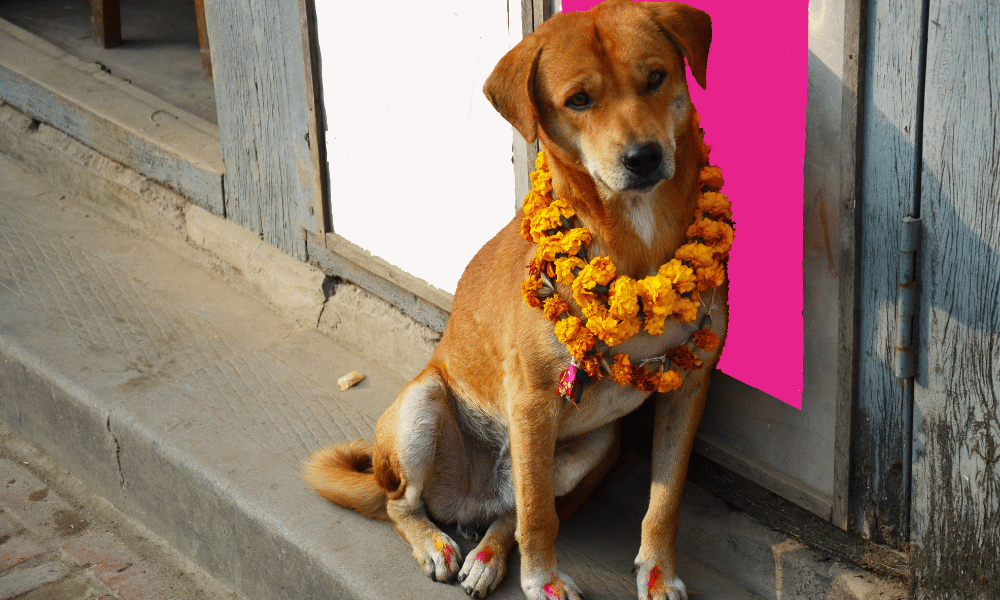
In addition to their spiritual significance, dogs have long been an integral part of Nepalese society, serving as protectors, herders, and companions. Kukur Tihar is an opportunity for people to express gratitude for the countless ways in which dogs contribute to human well-being and happiness.
Kukur Tihar is observed on the second day of the Tihar Festival and is dedicated to honoring and worshipping dogs. The rituals and customs associated with Kukur Tihar are as follows:
On this day, both pet dogs and stray dogs are celebrated and honored. Family members prepare special offerings for the dogs, which may include a variety of food items, such as meat, milk, eggs, and other dog-friendly treats.
Dogs are adorned with garlands made from marigold flowers, known as "malla," which symbolize their sacred status and importance in the community. The garlands also serve as a gesture of gratitude and respect towards the dogs for their loyalty, companionship, and protection.
A Tika, a mixture of red vermilion, rice, and yogurt, is applied to the dogs' foreheads, signifying their sacred status and seeking their blessings for the family's well-being and prosperity.
In some communities, people light oil lamps near the dogs' resting places, symbolizing the dispelling of darkness and the guidance provided by these faithful companions.
By participating in the rituals and customs of Kukur Tihar, people express their appreciation for the invaluable role that dogs play in their lives, while also fostering a sense of harmony and respect between humans and animals.
Goddess Laxmi is a highly revered deity in Hinduism, symbolizing wealth, prosperity, abundance, and good fortune. She is the consort of Lord Vishnu, the preserver of the universe, and is believed to bestow her blessings upon those who diligently worship her. Laxmi Puja, observed on the third day of Tihar Festival, holds immense significance as it is dedicated to the worship of Goddess Laxmi, seeking her divine grace for material and spiritual prosperity.
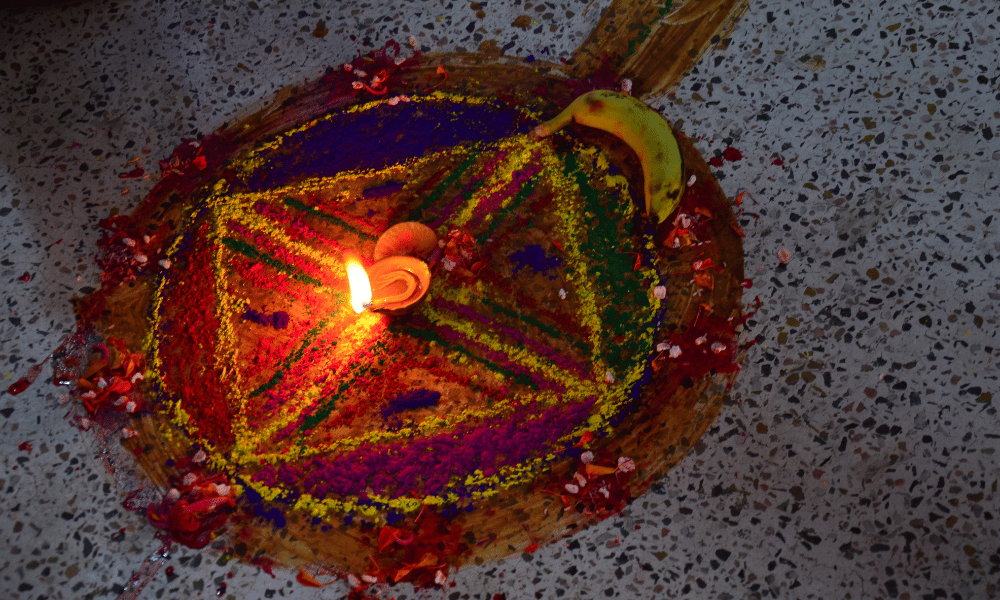
Laxmi Puja is a time for families to come together and perform various rituals and customs to honor and worship Goddess Laxmi. Some of the key rituals and customs associated with Laxmi Puja include:
Thoroughly cleaning the home and its surroundings, as it is believed that Goddess Laxmi resides in clean and well-maintained spaces. This ritual is symbolic of purifying one's environment to invite positive energy and prosperity.
Creating intricate Rangoli designs at the entrance of the home, using colored powders, rice, or flower petals. These vibrant designs are believed to welcome Goddess Laxmi and bring good fortune.
Lighting oil lamps (diyas) and candles throughout the house, signifying the victory of light over darkness and inviting the divine light of Goddess Laxmi into the home.
Setting up a sacred altar with images or idols of Goddess Laxmi, along with offerings of flowers, incense, fruits, sweets, and coins. Families gather to perform prayers and recite hymns in praise of the goddess, seeking her blessings for wealth, success, and happiness.
In some communities, people also worship their business ledgers, tools, or equipment during Laxmi Puja, seeking the goddess's blessings for success and prosperity in their professional endeavors.
Deusi-Bhailo is a popular Nepalese tradition that takes place during the Tihar Festival, particularly on the night of Laxmi Puja. Groups of people, often young boys and girls, go door-to-door in their neighborhoods, singing traditional Deusi-Bhailo songs and dancing to the rhythm of musical instruments. The songs typically convey messages of good fortune, blessings, and happiness for the households they visit.
In return, homeowners offer the performers money, food, or other gifts as a token of gratitude and goodwill. The collected offerings are often used to organize community feasts or donated to charity. The Deusi-Bhailo tradition fosters a sense of unity, joy, and shared celebration among the members of the community.
Cows hold a sacred status in Hinduism and are highly revered in Nepalese culture. They are considered the symbol of wealth, abundance, and fertility. Cows also represent motherhood, as they provide milk and nourishment, and are often referred to as "Gau Mata" or "Mother Cow." In Hindu mythology, cows are associated with Lord Krishna, who was a cowherd, and the deity Kamadhenu, the wish-fulfilling divine cow. Gobardhan Puja, observed on the fourth day of Tihar Festival, honors cows and their significance in Hinduism and Nepalese society.
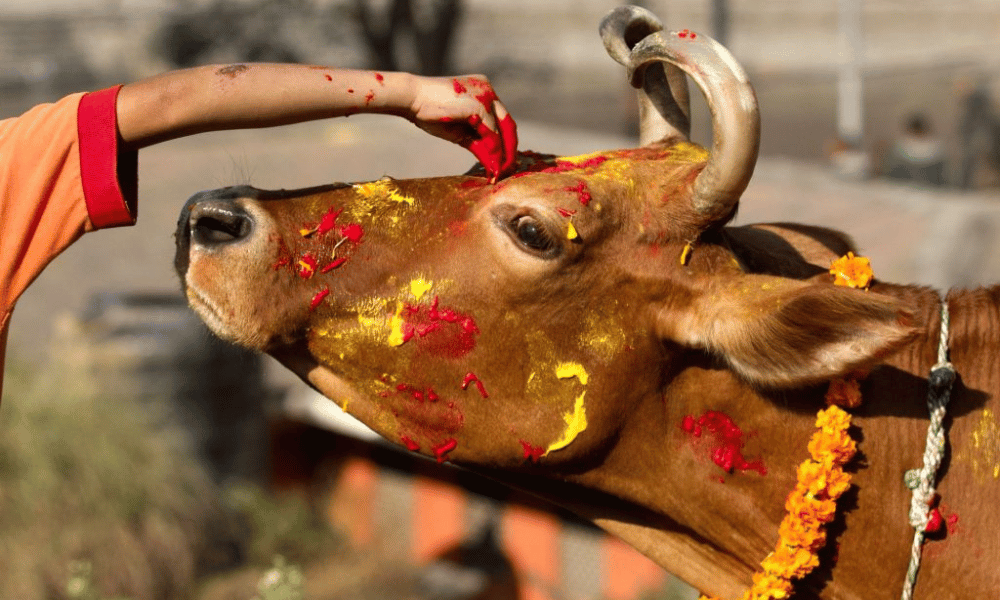
Gobardhan Puja involves various rituals and customs to honor and worship cows. Some of the key rituals associated with Gobardhan Puja include:
Bathing and grooming cows early in the morning, as a sign of respect and gratitude for their contributions to human life.
Adorning cows with garlands made from marigold flowers and applying a Tika (a mixture of red vermilion, rice, and yogurt) on their foreheads, symbolizing their sacred status and importance in the community.
Offering cows a special meal consisting of grass, grains, fruits, and other nutritious food items, as a token of appreciation for their role in providing sustenance and nourishment.
In some communities, people also create small mounds of cow dung, representing the Gobardhan Hill, and decorate them with flowers and colored powders. These mounds are then worshipped as a symbol of abundance and prosperity.
Mha Puja, also observed on the fourth day of Tihar, is a unique tradition practiced mainly by the Newar community in Nepal. Mha Puja, which translates to "self-worship," is a ritual that focuses on honoring one's own body, mind, and soul, recognizing the divinity within each individual. This ritual encourages self-awareness, spiritual growth, and introspection.
During Mha Puja, family members gather and create a sacred space, often by drawing intricate mandalas on the floor using colored powders, rice, or flower petals. Each person sits on their designated spot within the mandala and is offered various items, including fruits, sweets, flowers, and a lighted oil lamp. These offerings symbolize prosperity, health, and spiritual illumination. The ritual also involves applying a Tika on one's own forehead and reciting prayers or mantras to invoke the divine energy within oneself.
The significance of Mha Puja lies in promoting self-care, self-love, and the realization of one's inner potential and divine nature. By acknowledging and honoring the divine within, individuals are encouraged to cultivate positive qualities, such as compassion, kindness, and wisdom, ultimately contributing to their overall well-being and personal growth.
Bhai Tika, observed on the fifth and final day of the Tihar Festival, is a special occasion that celebrates the bond between brothers and sisters. It is a day dedicated to strengthening the love, support, and connection between siblings, emphasizing the importance of family relationships. Bhai Tika serves as an opportunity for brothers and sisters to come together, express their affection for each other, and renew their commitment to support and protect one another.

The rituals and customs of Bhai Tika are centered around the relationship between brothers and sisters. Some of the key rituals associated with Bhai Tika include:
Sisters prepare a sacred space, often by drawing intricate designs or mandalas on the ground using colored powders, rice, or flower petals. This space serves as the setting for the Bhai Tika ceremony.
Sisters apply a Tika (a mixture of red vermilion, rice, and yogurt) on their brothers' foreheads, signifying the bond between siblings and seeking divine blessings for their brothers' health, happiness, and prosperity.
A garland made of marigold flowers, called "malla," is placed around the brothers' necks as a symbol of love, respect, and protection.
Sisters offer various food items to their brothers, including fruits, sweets, and homemade delicacies, symbolizing love and nurturing.
In return, brothers also apply a Tika on their sisters' foreheads and present them with gifts, expressing their gratitude and love for their sisters.
The exchange of gifts and blessings during Bhai Tika is an important aspect of the celebration, fostering a sense of mutual love, support, and appreciation between siblings. Brothers typically offer gifts to their sisters, which may include clothes, jewelry, or other tokens of affection, symbolizing their commitment to protect and care for their sisters. In return, sisters bless their brothers with wishes for a long, healthy, and prosperous life.
The exchange of gifts and blessings during Bhai Tika helps to reinforce the sibling bond, create lasting memories, and ensure the continuation of this cherished tradition in the family and community.
The aesthetic elements of Tihar Festival, such as Rangoli and the use of lights and diyas, add vibrancy and beauty to the celebrations. Rangoli, an art form involving intricate, colorful designs made from colored powders, rice, or flower petals, symbolizes good fortune and spiritual purity. Lights and diyas, an essential part of the festivities, represent the triumph of light over darkness and the dispelling of ignorance. These aesthetic elements not only enhance the visual appeal of the festival but also carry deep symbolic significance, embodying the core values and spiritual essence of Tihar, while contributing to the joyous and festive atmosphere.
Rangoli is a traditional Indian art form that involves creating intricate and colorful designs on the ground using materials like colored powders, rice, flower petals, or even chalk. The art of Rangoli has been practiced for centuries across India and Nepal, particularly during festivals and celebrations. Rangoli designs are often symmetrical, featuring geometric patterns, floral motifs, or depictions of deities and other auspicious symbols.
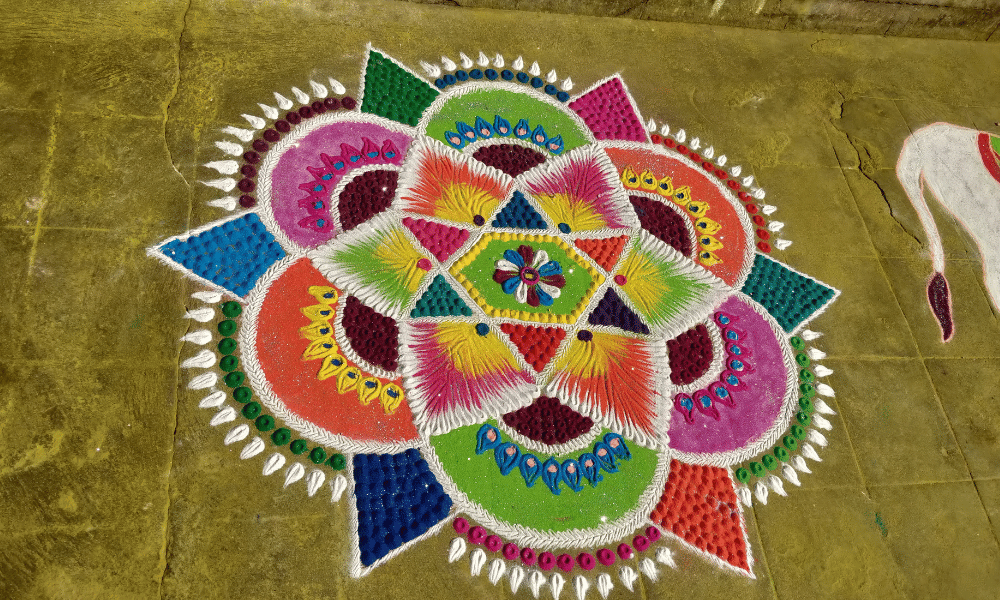
The process of creating Rangoli requires skill, patience, and creativity, as artists carefully arrange the materials to form detailed and visually stunning designs. In many cases, creating Rangoli is a collaborative effort, with family members or community members working together to develop and execute the design.
The symbolism of Rangoli in Tihar
During the Tihar Festival in Nepal, Rangoli plays a significant role in the celebrations, particularly on the third day, Laxmi Puja. Rangoli designs are created at the entrance of homes, courtyards, or even inside the house, with the primary purpose of welcoming Goddess Laxmi, the goddess of wealth and prosperity, into the home.
The symbolism of Rangoli in Tihar goes beyond its association with Goddess Laxmi. It is also seen as a representation of the vibrant and colorful nature of the festival itself, reflecting the joy and happiness associated with the celebrations. Additionally, Rangoli designs are believed to bring good fortune and positive energy, warding off evil spirits and negativity.
Creating Rangoli during Tihar is also a way for people to express their creativity and showcase their artistic skills, while also fostering a sense of unity and collaboration among family members and the community. In this way, Rangoli serves as both a form of artistic expression and a symbol of cultural and spiritual significance during the Tihar Festival.
Light plays a crucial role in the Tihar Festival, symbolizing the victory of light over darkness, knowledge over ignorance, and good over evil. In Hinduism, light is often associated with divine energy, wisdom, and spiritual enlightenment. During Tihar, the use of lights and diyas (traditional oil lamps) helps to create a festive atmosphere and serves as a reminder of the spiritual significance of the celebration.
By illuminating their homes and surroundings with lights, people create an environment of positivity, warmth, and joy. The light is believed to attract the blessings of the deities, particularly Goddess Laxmi, who is said to favor well-lit and clean spaces. Moreover, the presence of light is thought to ward off negative energies and evil spirits, promoting harmony and well-being within the household and the community.
The tradition of lighting diyas and candles during Tihar
Lighting diyas and candles is an integral part of the Tihar Festival, and various rituals and customs revolve around the use of light. Some of the key aspects of the tradition include:
On Laxmi Puja, the third day of Tihar, families light diyas and candles throughout their homes to welcome Goddess Laxmi and seek her blessings for prosperity and abundance.
In addition to diyas and candles, people may also use decorative electric lights, lanterns, or even firecrackers to illuminate their homes and surroundings.
On Kukur Tihar (Dog Day), some communities light oil lamps near the resting places of dogs as a symbol of guidance and protection provided by these faithful companions.
During Bhai Tika (Brother-Sister Day), sisters light an oil lamp during the Tika ceremony, signifying the warmth and light of their love and support for their brothers.
The tradition of lighting diyas and candles during Tihar not only adds to the festive ambiance but also serves as a visual reminder of the spiritual values and beliefs at the heart of the celebration. By participating in this tradition, individuals connect with the deeper meanings of Tihar and strengthen their connection to their faith and community.
Deusi-Bhailo is a traditional Nepalese musical performance that plays a prominent role during the Tihar Festival, particularly on the night of Laxmi Puja. Groups of people, often young boys and girls, form troupes and go door-to-door in their neighborhoods, singing traditional Deusi-Bhailo songs and dancing to the rhythm of musical instruments such as the Madal (a type of drum) and harmonium.
The songs typically convey messages of good fortune, blessings, and happiness for the households they visit. The performers are warmly welcomed, and in return for their performance, homeowners offer them money, food, or other gifts as a token of gratitude and goodwill. The collected offerings are often used to organize community feasts or donated to charity.
The Deusi-Bhailo tradition is significant because it fosters a sense of unity, joy, and shared celebration among the members of the community. It encourages social interaction, strengthens relationships, and helps preserve the cultural heritage of Nepal.
Other popular songs and dances during the festival
Apart from Deusi-Bhailo, there are several other popular songs and dances associated with the Tihar Festival. Some of these include:
Mha Puja songs: During Mha Puja, the Newar community sings traditional Newari songs to celebrate the occasion. These songs are often accompanied by traditional musical instruments like the dhime (a Newari drum) and the taa (cymbals).
Tihar folk songs: Various folk songs are sung during different days of the Tihar Festival, reflecting the diverse customs and traditions of the Nepalese people. These songs convey stories, legends, and the cultural significance of the festival.
Traditional dances: Along with songs, traditional dances also form an integral part of Tihar celebrations. Each ethnic community in Nepal has its unique dance forms and styles that they showcase during the festival, expressing their cultural identity and adding to the richness of the celebrations.
The songs and dances of Tihar not only provide entertainment and enjoyment but also help preserve and promote the rich cultural heritage of Nepal. They bring people together, instill a sense of pride in their traditions, and create lasting memories of the celebrations.
Tihar Festival is renowned for its array of delicious traditional foods and delicacies that add to the celebratory atmosphere. Some of the most popular treats include Sel Roti, a deep-fried, ring-shaped rice flour bread; Anarsa, a sweet made from rice flour and jaggery; and Laakhamari, a visually stunning sweetened flour dessert crafted into intricate designs. These culinary offerings not only delight the taste buds but also serve as symbols of love, affection, and the sharing of joy. The preparation and consumption of these delicacies during Tihar strengthen bonds between family members, friends, and the community while preserving and promoting Nepal's rich culinary heritage.
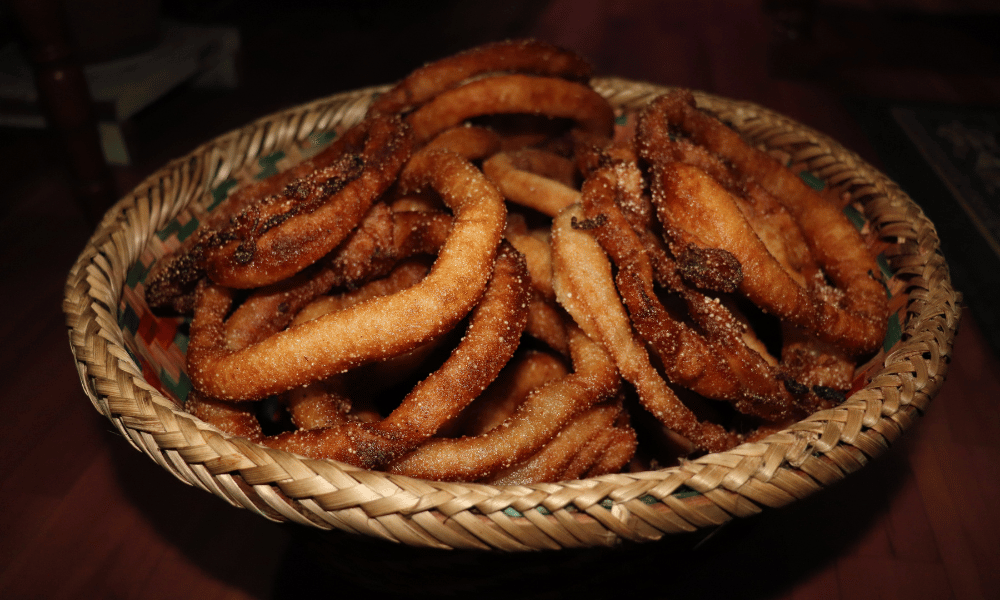
Sel Roti is a traditional Nepalese delicacy that is commonly prepared during the Tihar Festival. It is a deep-fried, ring-shaped bread made from rice flour, sugar, milk, and spices like cardamom and cinnamon. The mixture is poured into hot oil using a funnel or a cloth with a hole, creating a circular shape. The result is a crispy, golden-brown bread with a soft, slightly sweet interior. Sel Roti is often served with yogurt or vegetable curry and is enjoyed as a snack or breakfast item during the festival.
Anarsa is a sweet treat made from rice flour, jaggery (unrefined sugar), and ghee (clarified butter). The ingredients are combined to form a dough, which is then shaped into small discs and deep-fried in ghee until golden brown. Anarsa has a slightly crunchy exterior and a soft, sweet, and melt-in-your-mouth texture. It is a popular dessert during Tihar and is often shared among family members and friends as a symbol of love and affection.
Laakhamari is a traditional Nepalese sweet that is often prepared during Tihar and other festivities. Made from sweetened flour, Laakhamari is shaped into intricate and artistic designs before being deep-fried and glazed with sugar syrup. The result is a visually stunning and delicious treat that is enjoyed by people of all ages. Laakhamari is often exchanged as a gift during Tihar, symbolizing goodwill and the sharing of joy.
During Tihar, it is customary for many families to observe a vegetarian diet, abstaining from meat and alcohol. This practice is rooted in the festival's focus on purity, spirituality, and the reverence for life. By consuming vegetarian food, individuals honor the bond between humans, animals, and nature, emphasizing the need for compassion and respect for all living beings. Vegetarian dishes, including various lentil, vegetable, and rice preparations, form an essential part of the Tihar feast.
Food plays a central role in Tihar celebrations, serving as a means to bring people together, express love and gratitude, and share blessings. Traditional dishes and sweets are prepared with great care and attention, using recipes passed down through generations. These delicacies are not only enjoyed by family members but are also offered to deities, animals, and visitors during the festival, symbolizing hospitality, generosity, and the sharing of joy. The act of preparing and sharing food during Tihar strengthens bonds between family members, friends, and the community, while also preserving and promoting the rich culinary heritage of Nepal.
Related Blog: Nepalese Food
The Tihar Festival, a significant celebration in Nepal, greatly impacts Nepalese society and tourism. The festivities, deeply rooted in the country's cultural heritage, contribute to the preservation and promotion of traditions and values, while also strengthening community bonds. The economic impact of Tihar is evident in the boost it provides to local businesses, markets, and the tourism sector. The festival attracts both domestic and international tourists who come to witness and participate in the unique customs and celebrations. Overall, Tihar Festival plays a vital role in fostering unity, shared joy, and a sense of national pride, while bolstering Nepal's economy and raising global awareness of its rich cultural legacy.
Boost in local businesses and markets
The Tihar Festival has a significant impact on the local economy in Nepal. As one of the most important and widely celebrated festivals, Tihar sees a surge in consumer spending as people purchase items such as decorations, lights, candles, diyas, gifts, clothes, and food. Local businesses and markets benefit from this increased demand, leading to higher sales and profits during the festival season.
In addition to retail businesses, Tihar also provides opportunities for small-scale entrepreneurs and artisans, who create and sell traditional handicrafts, decorative items, and festive food products. These individuals benefit from the increased interest in cultural and traditional items during the Tihar celebrations.
The festival's influence on tourism
Tihar also plays a role in promoting tourism in Nepal. The vibrant festivities, rich cultural traditions, and unique customs associated with Tihar attract both domestic and international tourists, who come to witness and participate in the celebrations. This influx of visitors boosts the tourism sector, with hotels, restaurants, and tour operators experiencing increased demand during the festival period.
Furthermore, the Tihar Festival helps to raise global awareness of Nepal's culture and heritage, drawing the attention of potential tourists and encouraging future travel to the country. The festival's positive impact on tourism contributes to the overall growth and development of the Nepalese economy, creating opportunities for local businesses and communities.
The Tihar Festival plays a crucial role in preserving and promoting the rich cultural heritage of Nepal. The various customs, rituals, and traditions associated with the festival are deeply rooted in Nepalese history and folklore, reflecting the diverse beliefs and practices of the people. By celebrating Tihar, individuals not only honor their cultural roots but also pass on these traditions to future generations, ensuring their continued survival and relevance.
Moreover, Tihar serves as a platform for showcasing the unique cultural aspects of Nepal, such as traditional music, dance, art, and food. These elements of the festival contribute to a sense of national pride and identity, helping to foster a greater appreciation for the country's heritage and distinctiveness.
Strengthening of community bonds and relationships
Tihar has a significant impact on community bonds and relationships, promoting unity, cooperation, and goodwill among the people. The festival encourages social interaction and mutual support, as neighbors, friends, and family members come together to prepare for and participate in the celebrations.
Activities such as Deusi-Bhailo performances and the exchange of gifts and blessings during Bhai Tika further strengthen interpersonal relationships, fostering a sense of belonging and shared joy. The festival also serves as an opportunity for reconciliation and the mending of strained relationships, as the spirit of Tihar encourages forgiveness, compassion, and understanding.
The emphasis on honoring and respecting the bond between humans, animals, and nature during Tihar also contributes to a greater sense of community and interconnectedness. By celebrating these relationships, individuals recognize the importance of treating all living beings with kindness and respect, reinforcing values that are essential for harmonious living and the well-being of society.
In conclusion, the Tihar Festival in Nepal is a vibrant and deeply significant celebration that showcases the rich cultural heritage and spiritual values of the country. With its unique customs, rituals, and traditions, the festival honors the interconnectedness of humans, animals, and nature, promoting unity, love, and gratitude within the community. The aesthetic elements, traditional foods, and the focus on relationships further enhance the joyous atmosphere of Tihar.
Experiencing the Tihar Festival in Nepal is an unforgettable opportunity to immerse oneself in the country's rich culture and traditions, while witnessing the warmth and unity of the Nepalese people. We encourage readers to consider visiting Nepal during the Tihar Festival to participate in this extraordinary celebration, which offers a deeper understanding of the values and beliefs that shape the nation's identity and fosters a sense of global interconnectedness.
Get in touch with our experts right away and finalize an experience!
About UsTihar Festival, also known as Deepawali or Diwali in Nepal, is a five-day Hindu festival celebrated in Nepal. It is a time to honor the relationships among humans, animals, and nature, as well as the victory of good over evil.
Tihar Festival is usually celebrated in October or November, depending on the lunar calendar. The specific dates vary each year.
Rangoli is an art form involving intricate, colorful designs made from colored powders, rice, or flower petals. It symbolizes good fortune and spiritual purity during the Tihar Festival.
Some popular Tihar Festival foods and delicacies include Sel Roti (rice flour bread), Anarsa (rice flour and jaggery sweet), and Laakhamari (sweetened flour twisted into intricate shapes).
The five days of Tihar Festival are:
Kaag Tihar (Crow Day)
Kukur Tihar (Dog Day)
Laxmi Puja (Goddess of Wealth and Prosperity)
Gobardhan Puja (Cow Day) and Mha Puja (Self-worship)
Bhai Tika (Brother-Sister Day)
Lights and diyas play an essential role in the Tihar Festival, symbolizing the triumph of light over darkness and the dispelling of ignorance. They are used to decorate homes and public spaces during the celebrations.
The Tihar Festival attracts both domestic and international tourists who come to witness and participate in the unique customs and celebrations. This influx of visitors boosts the tourism sector, with hotels, restaurants, and tour operators experiencing increased demand during the festival period.